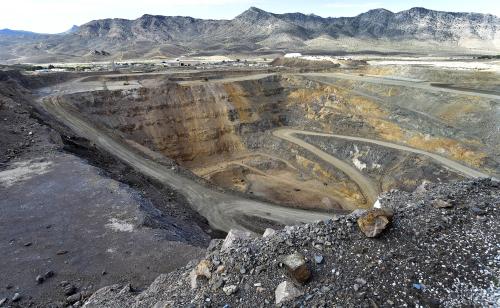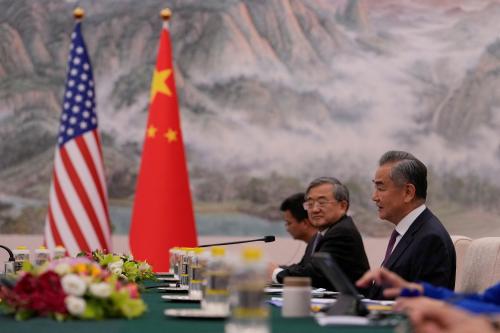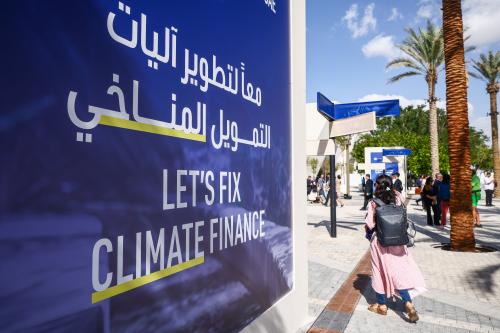“We have to consider every single source and every single option on reducing carbon and getting to a low carbon economy,” said Chris Crane, the president and CEO of Exelon Corporation, at a recent Brookings event on the changing dynamics of global energy and climate. “It’s got to be about cost, it’s got to be about safety, it’s got to be about reliability, but we can put the environment right on top with those [factors].”
Crane’s statement began his keynote speech at the event hosted by the Cross-Brookings Initiative on Energy and Climate to discuss the role of the energy industry in moving toward a lower carbon future. Exelon is a Chicago-based electric utility with 10 million customers and one of the largest U.S. power generators. After Crane’s keynote, David G. Victor, co-chair of the Initiative, joined Crane to discuss Exelon’s role in today’s changing business environment.
In his keynote, Crane emphasized the importance of reducing carbon emissions especially considering the recent report from the Intergovernmental Panel on Climate Change (IPCC). “We have to reduce [carbon emissions] dramatically, and it’s going to take a capital investment to do it, so we need to do it wisely,” he said. “We cannot expect our customers to bear unnecessary costs on this road to a low carbon future.” Crane noted that since 1990 the utility sector has seen a 25 percent reduction in its contribution to emissions, but because of the urgency reported by the IPCC and other studies, “we have to do something much more severe.”
What the absence of federal policies means for energy corporations
Victor asked Crane about how energy companies navigate the changing business landscape amid changes in federal policies, referencing the Baker-Schultz plan co-authored by former Secretaries of State James Baker and George Shultz that would tax carbon emissions and redistribute the revenues as a dividend to American taxpayers. “This is not the first time that the federal government has been decoupled from what the rest of the country wants. So help us understand what the pathway is going forward. Is [this] the right way for thinking about federal policy?” Victor asked.
For Crane, the push to move toward cleaner energy is driven by the customer base. “We know we’re just one small company in a large country. But we believe that coalitions of companies, public, private coalitions coming together can drive and make change … I think unfortunately we’re still having the debate [on] is the climate changing. I can tell you as an operator of utilities, the climate is changing.”
Existing incentive-based solutions are “second-best”
With shifts in federal policies under the Trump Administration, state elected officials have taken the reins toward reducing emissions and promoting cleaner energy, Crane explained. But Crane is hesitant to call policies such as zero-emissions credits solutions. “It’s a band aid … you can [consider] some countries that have done fantastic investments in renewables and now they’re having to get stability transmission in place and their electric costs are at the highest, their nuclear plants are shut down, but … reliability is being maintained by the dirtiest source, which is lignite. So you’re not seeing the reduction in carbon that they expected because they went after a technology and not a market based solution.”
“The most beneficial [solution] would be federal, but what we’ve got now just is buying us time,” Crane added.
In favor of nuclear energy: Why government should include nuclear in subsidies and credits
Throughout the conversation, Crane was adamant about the potential of nuclear energy. As a reliable, low-carbon emitting source of energy, he argued that it should be considered more prominently as a clean energy option. “Nuclear has the same social benefit [as other renewable resources], so you compensate it for its reliability,” he said. “It runs 24/7. It doesn’t have to have the wind blowing or the sun shining to provide power. During the polar vortex the nuclear plants ran straight through, there was not a problem with one of them. Coal piles froze up, natural gas pressures got too low, wind wasn’t blowing, and the sun wasn’t out … it provided a level of reliability and … should be compensated for that.”
In addition to nuclear, Crane emphasized the importance of looking for multiple energy solutions. “We don’t have to … [pick] one technology over the other, we can get to that renewable future. I don’t see us getting to a total 100 percent distributed generation grid anytime soon … But I do see distributed generation systems and micro grids being beneficial to society in certain locations that are fueled by hydrogen cells, they’re fueled by other sources, so they can run when the whole system is down.”
The role of energy companies needs to grow as the market changes
During the discussion, Victor brought up potential concerns considering that demand in the energy market “is no longer growing, it’s flat, [and] many markets now allow new entrants to come in who don’t necessarily have to pay all of the costs of the previous system.” He asked if Crane was worried about the future of the business as new innovative technologies are introduced.
Crane explained that these market changes ultimately benefit energy corporations by encouraging company growth, new ideas, and increased pressure to satisfy customers. He also noted the value of potential collaboration that comes from these innovative technologies. “What we’re finding in some cases, partnerships are very critical, especially in the world of digitization, in the world of energy efficiency, in the world of distributed generation,” he said. “We’re not going to be the most cost efficient individual company to put the solar panel on the roof, but if there’s a control element, an inverter that can better help us operate that system, we should partner with that solar provider working through our regulators to be allowed and be able to do that, so let us have a seat at the table.”
This event was the second of a series on “The new dynamics of global energy and climate.” The next event will feature a conversation with Rachel Kyte, CEO for Sustainable Energy for All on November 19. See additional event details and register here.
Mallory Rappaport contributed to this post.







Commentary
Highlights: An energy industry view on moving toward a lower carbon future
October 31, 2018